A community-led demonstration project has been installed at the intersection of North Portsmouth and Willis. As we reported back in July, the project is the result of a collaboration between the Transportation Research and Education Center (TREC) at Portland State University, tactical urbanism nonprofit Better Block PDX, and the City of Portland transportation bureau. Community partners included the Portsmouth Neighborhood Association, and Community Cycling Center, who works with the nearby Cesar Chavez School.
Traffic safety has been a grave concern for this community for years. After a student was struck by a hit-and-run driver while walking across the intersection in 2020, former Chavez School teacher Sam Balto responded to the PSU TREC/Better Block project pathway program request for proposals with ideas on how to improve safety. The project was accepted and a team of PSU urban planning students went to work on it. They led a design and public process with the goal of installing a temporary pop-up project that could be followed up by permanent infrastructure.
Their public process scored three design options: a mini-roundabout, bump-outs (a.k.a. curb extensions), and raised crosswalks. The mini-roundabout got the highest-score.
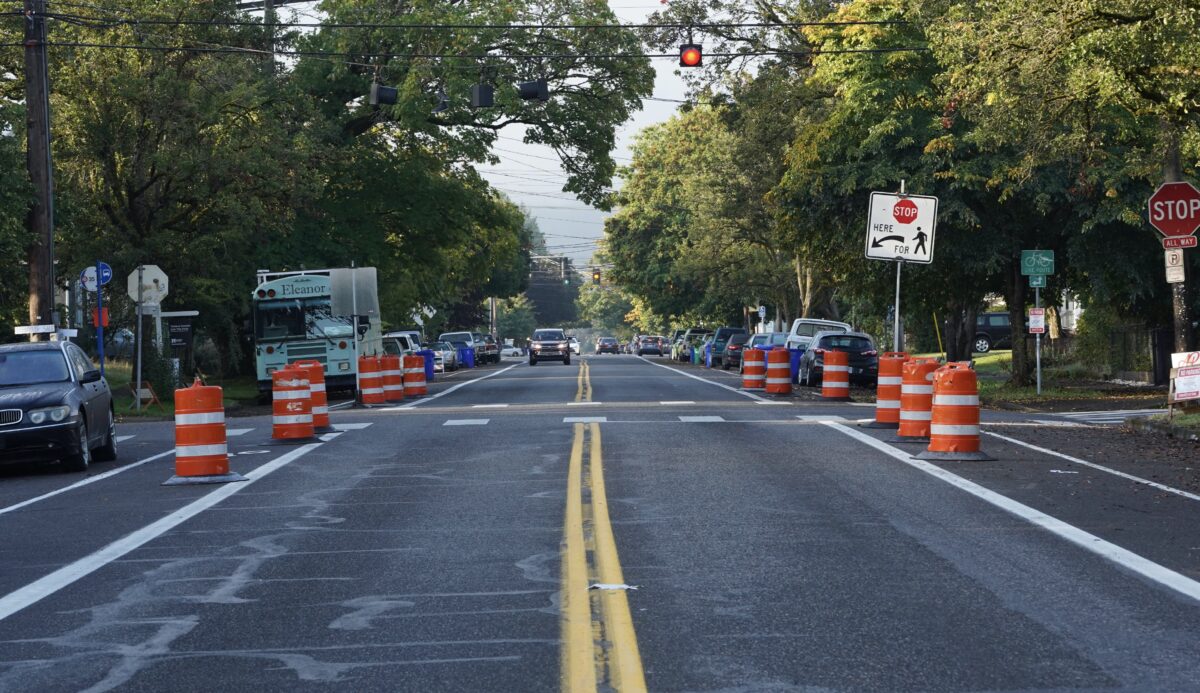
(Photos: Jonathan Maus/BikePortland)
When I visited the installation this morning I expected to see the roundabout. But it wasn’t there. Portsmouth Neighborhood Association Land Use and Transportation Chair Paul Buchanan was. He was disappointed PBOT wouldn’t sign off on the roundabout. I too was crestfallen that the roundabout got cut, but I watched several bus operators (both TriMet Line 35 and yellow school buses) negotiate the intersection and I can understand PBOT’s concerns.
Advertisement
I asked PBOT what happened. Spokesman John Brady said Better Block and other project partners all agreed on the decision. “The intent of the project was to improve pedestrian safety but the roundabout didn’t quite achieve improved safety beyond the fully controlled intersection it already is,” Brady explained. He also said they wanted the demonstration to be something that could become permanent, and there’s no funding or capacity to commit to a roundabout long-term. The short length of the pop-up was also a problem, Brady added, because they’d need more than a few days to analyze the roundabouts impacts on driver behavior.
Even without the star attraction, the pop-up includes several important elements:
- Parking is now prohibited at the corners. Using what’s known as intersection daylighting, PBOT has removed parking access of several spaces at each corner in a bid to improve visibility for all users.
- Barrels have been placed on Portsmouth as it approaches Willis. These are intended to act as temporary protective elements for the bike lane and medians that effectively shorten the crossing distance for pedestrians. The bike lane on Portsmouth is the standard, unprotected, door-zone variety. The pop-up project attempts to protect the bike lane as it approaches the intersection by moving it to the curb and placing barrels in the roadway.
- The barrels also force drivers to make sharper and slower turns, which is a major safety benefit.
- TriMet bus stop moved so operators don’t have to service the curb at encroach on the biking and walking space.
- New stop signs placed in the street to improve visibility and (hopefully) lead to higher compliance.
After observing the intersection this morning, it felt like the idea and concept was solid, the but the execution left something to be desired. It feels like a work zone, not an exciting vision of what a future – safer – intersection could look like. These pop-ups are meant to inspire users and create urgency for a permanent solution. The barrels are ugly and they don’t work well as a bike lane protector/median material in my opinion. The bike lane transition is abrupt and there’s one car that is parked way too close (it’s an abandoned car but has yet to be towed), so it partially blocks the bike lane when combined with a barrel. There’s also nothing that communicates to road users what’s going on.
A volunteer with Better Block PDX said the project is an exciting first for the PSU Pathway program. It’s also the first time PBOT contractors installed the traffic elements (instead of volunteers doing it).
The pop-up will be installed through the end of this coming Monday, so get over there and check it out and let us know what you think. There will be a post-mortem analysis that helps inform the future permanent design. Stay tuned.
— Jonathan Maus: (503) 706-8804, @jonathan_maus on Twitter and jonathan@bikeportland.org
— Get our headlines delivered to your inbox.
— Support this independent community media outlet with a one-time contribution or monthly subscription.



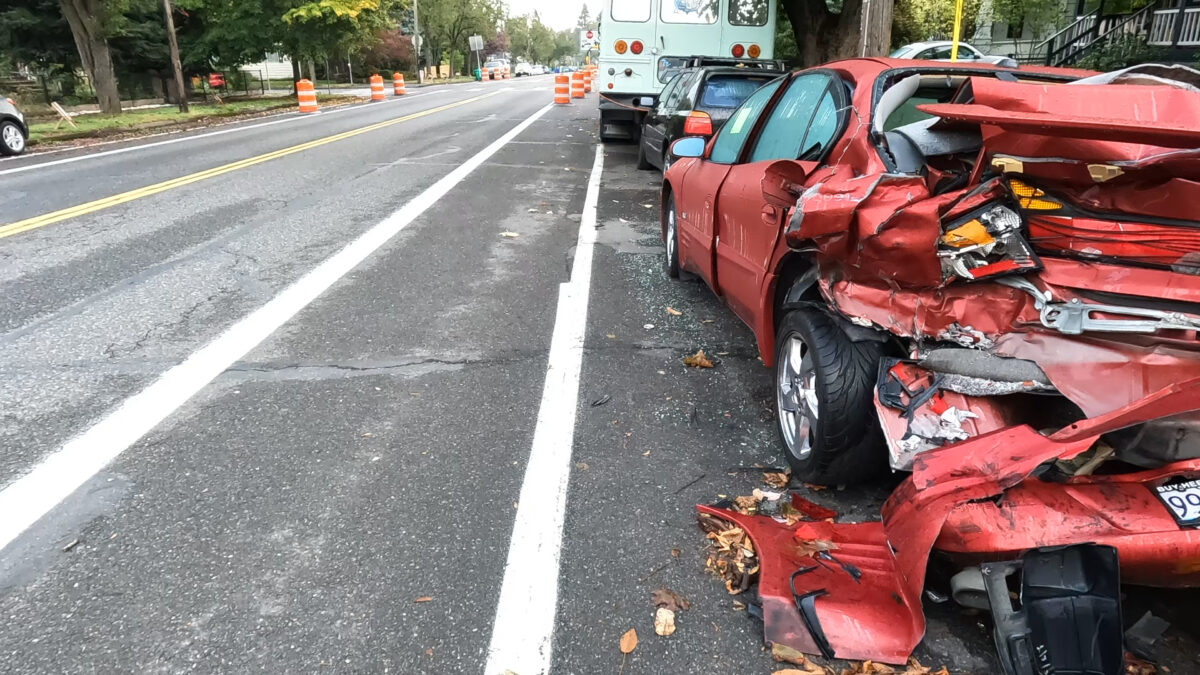

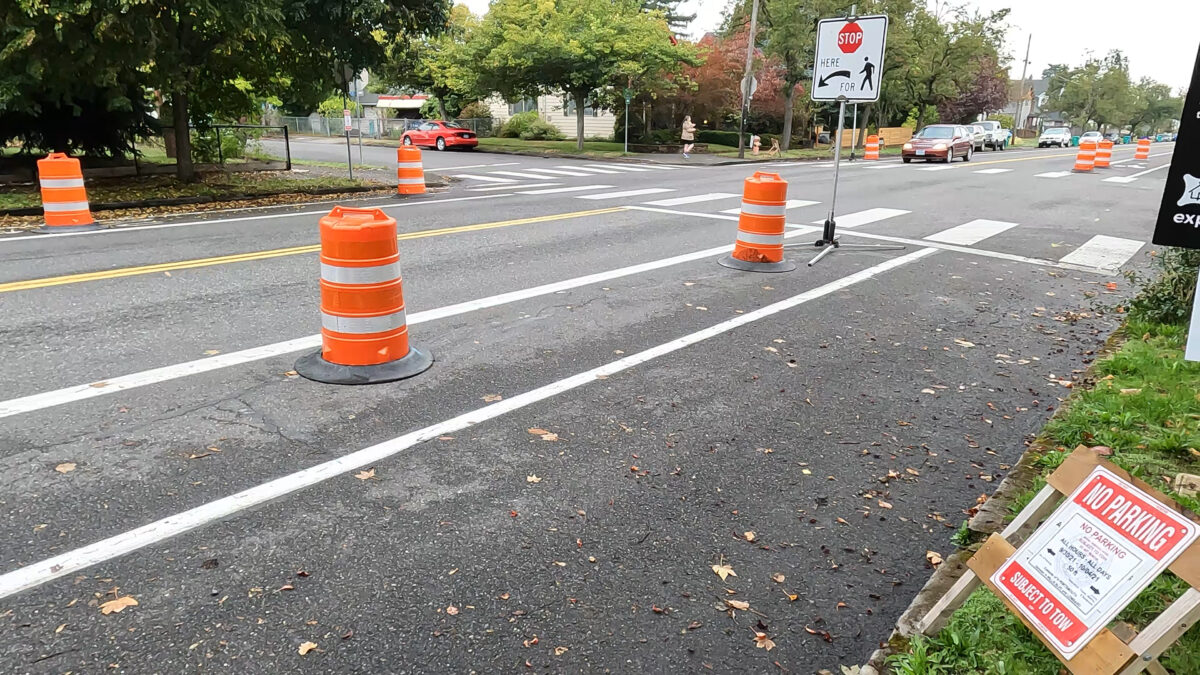
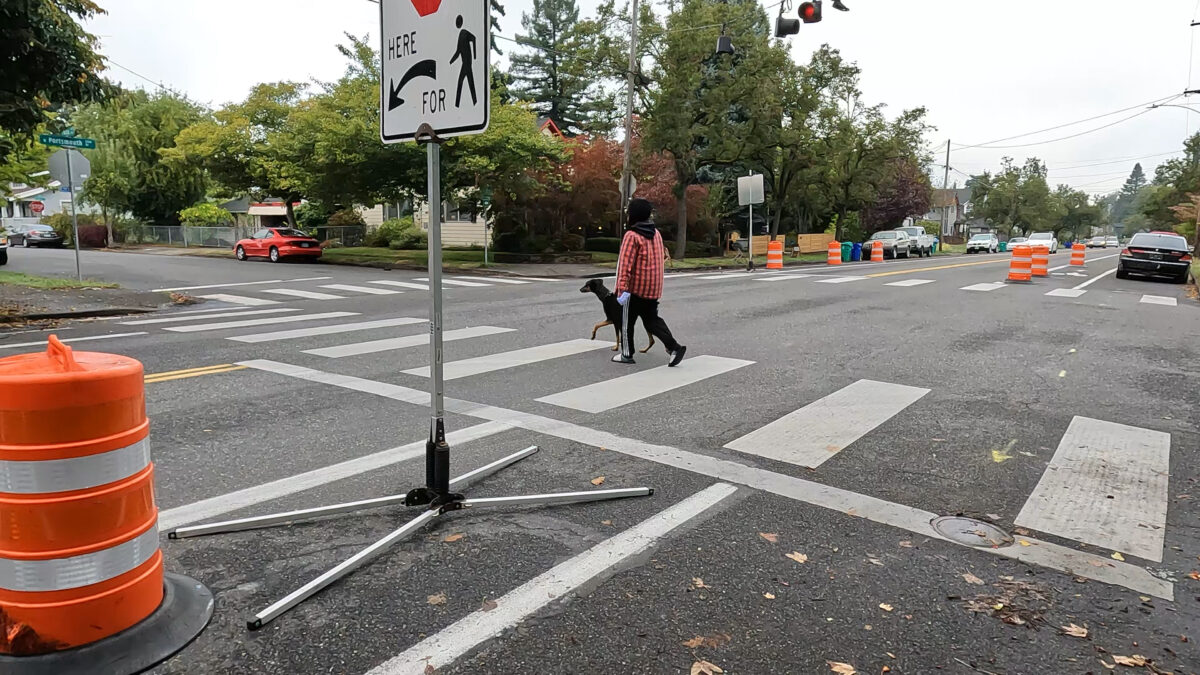
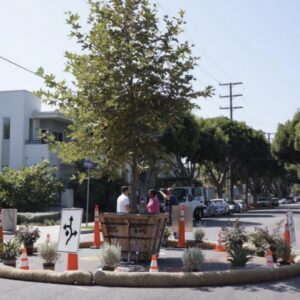
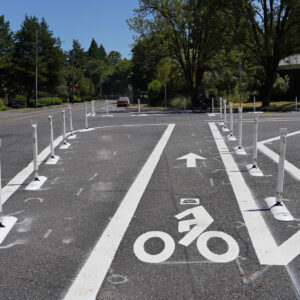
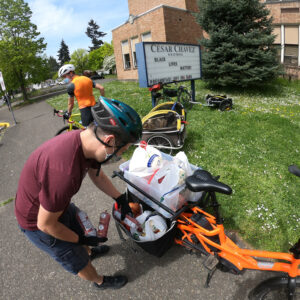
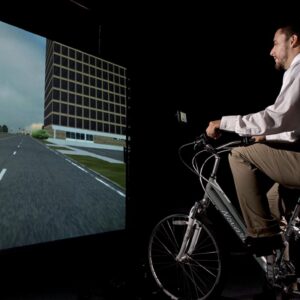
Thanks for reading.
BikePortland has served this community with independent community journalism since 2005. We rely on subscriptions from readers like you to survive. Your financial support is vital in keeping this valuable resource alive and well.
Please subscribe today to strengthen and expand our work.
I can’t even with this. So crushingly disappointing.
To put in all the effort for “public process” when the outcome is already decided is so mind-bogglingly wasteful not only of the effort and money involved but it pisses away any and all political capital that might have accumulated. Gosh, why aren’t people more engaged, we all wonder?
PBOT contractors were needed?? To simply roll barrels into the bikelane (not even in a straight line) and call it a day?
And at the end of the day how on earth are they going to “analyze […] driver behavior” for something like this? They are going to assume drivers/peds/cyclists will behave for some randomly scattered barrels with no explanation exactly like they would for actual curbs? What possible analysis can they glean from this? I am actually curious what sort of bureauspeak Mr. Brady would shovel on us as an answer to that. On second thought, no I’m not. I’m nauseated enough as it is.
I. can’t. even.
Oh well. Happy Friday, everyone.
PBOTs analysis is generally pretty low grade. I don’t think it has to do with the individuals conducting the analysis, just with how PBOT operates. They will probably do an afternoon of one-sample observations and then call it good.
Based on how helter-skelter that layout is, I wouldn’t be surprised in the slightest if some cyclist decides to move these hazards from the bike lane all together. It looks like someone made a mistake and so if you don’t know about this ‘experiment’, it’d be fair to assume those barrels aren’t supposed to be there.
Did you read the PSU student’s report? I did. They implied a roundabout would slow people driving. That’s true at a regular intersection, but this one has stop signs all around, so the score given the roundabout solution for slowing traffic is incorrect. A roundabout at this location would increase average vehicle speed, in addition to needing right of way to continue bus service.
Now the video is up, I very quickly see a driver proceeding through the intersection with a pedestrian already in the crosswalk. I see a car swerving hesitantly into the
bikebarrel lane to avoid the bus. Don’t barrels in the bike lane usually mean “bikes should enter the roadway” only now we don’t get the benefit of my favorite orange diamond BIKES IN ROADWAY sign?And this is all just going to go away on Monday?
Hope the analysis of driver behavior is going swimmingly. Somehow I assume that, again, the outcome has already been decided and any “analysis” will be finely tailored to support whatever they feel like doing anyway. (Do you think I’m being cynical in assuming that? Hmmm.)
I feel your pain and share a lot of it Mick. This doesn’t seem nearly as visionary and exciting as I think it should. It’s a baby step for a really cool collaboration between PSU/Better Block/PBOT and the n’hood that I think is very noteworthy. But arghh! One thing that’s weird to me is that PBOT contractors had to do the work. It’d be much better if Better Block could do the implementation because I have a feeling it would look and work a lot better.
Keep in mind that the PSU/Better Block folks are smart (and so are PBOTers but they just can’t seem to get out of their own way lately!) and hopefully they’ll learn and progress and make things better next time.
Fingers crossed! Thanks for explaining it all.
Always important to ask (maybe I missed?) what are the posted speeds here? Portsmouth and Willis are both non-arterial streets, and this looks like a residence district. Are they posted at 20? Getting 20 mph signs up is a key first step to getting engineers to approve measures that are needed to achieve those safe speeds. Details in the second half of this post here: https://bikeportland.org/2020/01/06/nw-portland-is-now-a-slow-zone-heres-how-your-neighborhood-can-be-one-too-309150
Hardly relevant at a stop sign approach.
Those informational signs in the steet are NOT stop signs.
Per the driving test everyone had to take to get a license, black and white signs are regulatory.
You’re right – it mostly just looks like a construction zone.
It’ll be interesting to see what it looks like during rush hour on Monday. Will people observe the crummy looking No Parking signs? When cars are queued up, will impatient drivers repurpose that daylighted parking lane as a right turn lane? Will all those barrels still be in the same place by then?
You would think that the blinking red light would be enough to indicate this is a four-way stop. Those little white stripes? You are supposed to stop before them, they are crosswalks. Regardless, it’s my opinion that it’s probably time for a traffic signal at this intersection. Drivers seem to have difficulty negotiating right of way, pedestrians, and understanding space and place. Driving is a lost art time for the computers to take over speed and maybe navigation in the future. Sad that I trust computers over humans but computers don’t take their eyes off the road, speed, or drive impaired. Or we could get a bit more strict in our driver testing?
Rant Rant Rant. Sorry hits a nerve. Seen a lot. Thanks.
As an admittedly way too frequent user of this intersection,I couldn’t agree more. A signal at this intersection is the only way to accomplish some form of compliance.
$300,000 to $500,000 for what safety problem, exactly?
Wasn’t this the intersection that was supposed to get a small traffic circle? Did they already walk back on that? Or am I confusing it with another spot?
I live really close to this intersection and ride/drive/walk past it pretty frequently and honestly have never had any problem with it and I’m surprised it had an accident occur. Willis is really only trafficked coming from the east, the west side is just a quiet neighborhood street. The real threat, if any, is people on Portsmouth not realizing they have to stop again a block from Lombard. The stop signs are a bit hard to spot, but they also have a flashing red light installed in the middle that’s very easy to see. I’m glad they Daylighted it though, having extra visibility always helps, so hopefully that’s permanent
How would you test a mini-roundabout here for four days with the bus turns?
How does a mini-roundabout make the intersection safer for pedestrians than an all-way stop?
They did walk back on the small traffic circle. That design was from TREC and PSU students getting DIRECT FEEDBACK from the communtiy and PBOT walked back on a year of community input and work with TREC students.
I am encouraging those students, TREC faculty and members of the Chavez community to reach out to PBOT staff about this waste of public time and effort